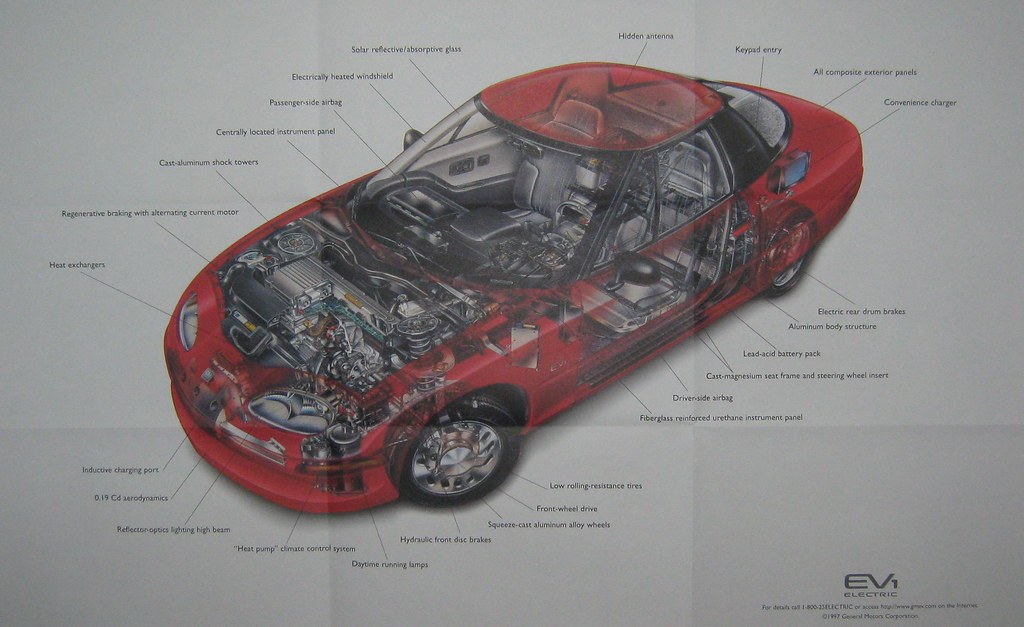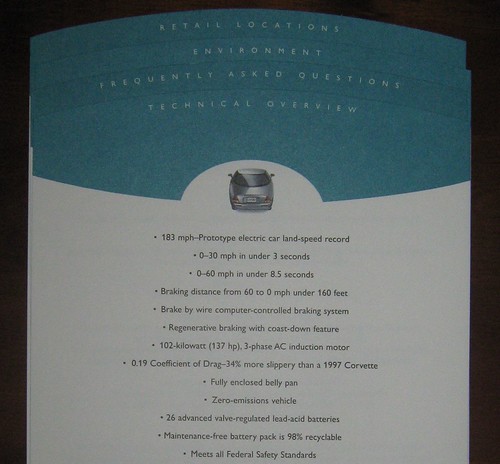While at the Green Drive Expo last month, a gentleman from the University of Wisconsin gave me some EV1 documents. I have a poster, a brochure on the first-gen, and a small pamphlet on the second gen. I've uploaded a few photos to my photostream:
Flickr: mdgates' Photostream

The EV1 strikes me as being similar to the Insight in its relentless pursuit of efficiency, but with an even larger budget and perhaps greater dedication to the goal. Where the Insight uses aluminium and plastic, the EV1 uses Al, Mg and fiberglass (in the suspension even!).

Power steering is electrohydraulic - an electric motor turning a pump when it is needed. They claim up to 65% reduction in energy usage versus always-running hydraulic power steering.
Here's a fairly good photo of the boattailed GM Impact at Fort Stockton. Unfortunately, the blur is built in to the brochure.

The pamphlets list the weight of several components:
Curb weight, lead acid, gen 1: 2970lbs
Battery pack, lead acid, gen 1: 1175lbs (16.3KWh)
Battery pack, lead acid, gen 2: 1310lbs (18.7KWh)
Battery pack, NiMH: 1147lbs (26.4KWh)
For comparison, the Nissan Leaf will have a 660lb LiFePO4 battery with 24KWh.
Body-in-white: 290lbs (versus 580lbs for a 1996 Dodge Stratus, which doesn't have to haul a 1200lb battery)
Motor: 150lbs
Wheels: 8.5lbs each, versus the Insight's 12lbs.
Somehow, the battery weight numbers remind me of Dave Cloud's Dolphin. Such a large portion of its energy is spent hauling around that massive battery. Imagine what an EV1 would do with 550lbs of lithium instead.
Here's the energy consumption data given, for city - highway
300Wh/mi - 250Wh/mi first-gen lead acid
260Wh/mi - 260Wh/mi second-gen lead acid
340Wh/mi - 300Wh/mi second-gen NiMH
It doesn't say, but I'm assuming that's on the old EPA cycle. I have no idea why the NiMH figure would be higher, considering that car is lighter. The first line is from a different pamphlet than the others, and there might have been changes to the test procedure that could explain the inconsistent result.
The most surprising thing about the EV1, I think, is its drag coefficient: 0.19. That's excellent, but not out of reach. True, you can't buy an EV1, but you can buy a Honda Insight, which has 0.25. Unlike the EV1, it has a radiator grille and an incomplete bellypan. Electrify an Insight, seal up the grille, engine bay, and exhaust tunnel, and you'll have close to the same Cd. Then consider that your Insight EV could be almost 1000lbs lighter, and you'd be approaching or exceeding the efficiency of the EV1.